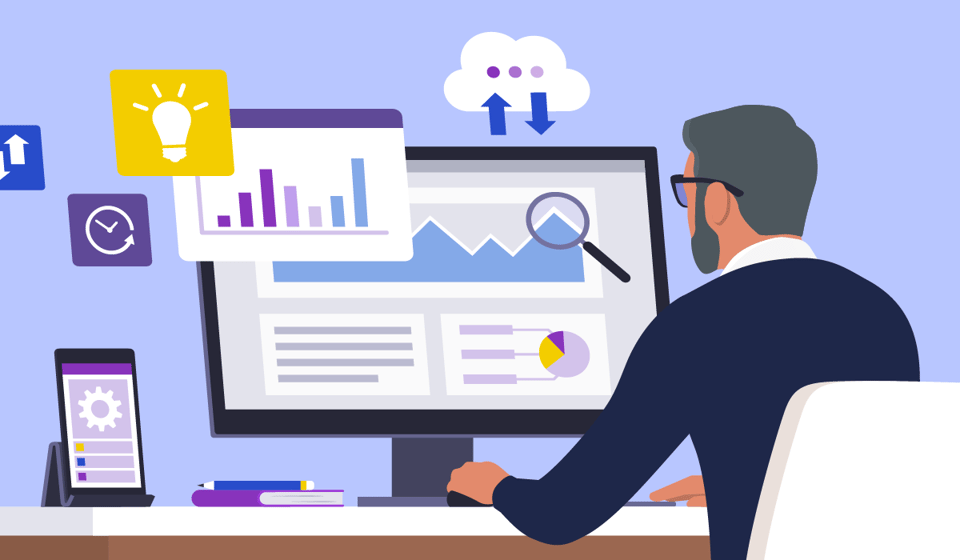Current trends in our highly digitized world make one thing very clear: Digitization and automation will continue to transform facility management as we know it.
Facility management requires leaders to manage multiple areas. From task management to health and safety to implementing more efficient processes, facility management is ultimately made easier with the right technology assets, methods, and approaches to managing properties and people through optimal processes.
Learn how to harness the power of technology to ensure your facilities keep running smoothly and your guests and employees stay happy, now and in the future.
Game-Changing Trends Impacting Facility Management
Multiple studies have found that the COVID-19 pandemic accelerated digital technology adoption across virtually every industry, and business function, and area of daily life by as much as seven years.
1. Remote Communications
The need to accommodate communications and transactions at a distance has not only driven the adoption of technologies at the consumer level, but through entire supply chains. Facility operators, and particularly operators of public spaces, such as event venues, should take note.
The pandemic forced many organizations to make adjustments to the ways employees work. In fact, according to research from CBRE, many U.S. companies are trending toward a permanent hybrid workforce. The need to keep distributed workforces connected, informed, and effective has accelerated technological investment and development. Even in functions such as venue management, that may have seen far less operational activity during the worst of the pandemic, the knock-on effects of broader technological trends in society will continue to impact the rate of change across facility management.
2. Consolidation of Workplace Technology
As more technologies are adopted, more companies seek a single simplified solution to mitigate the resulting tech debt. Tech debt is the unforeseen additional direct and indirect costs resulting from implementing an easier, or cheaper limited technology now instead of a better solution that might take longer or cost more upfront.
A common source of tech debt across all industries and functional areas is the adoption of multiple discrete technology platforms where a single platform would do. When multiple platforms are used, additional recurring (if not also routine) investment in time or money is required to make the different systems work together or manually consolidate the data between the platforms for analysis and decision making.
While no single platform yet exists that does everything a facility may need, facility operators should look to consolidate wherever possible to better drive efficiencies.
3. Better Data Analytics to Inform Decision-Making
With the accelerating adoption of digital information technology has come the increase in data generated by sensors and software, and tools for extracting value from that data. As a Gartner report on data analytics trends mentioned, one of the fundamental potential benefits of data is the power to manage uncertainty.
In facility management, the variety and volume of data continues exponential growth. We expect this trend to continue for many years. As the pace of digitization accelerates, facility leaders will increasingly look for ways to transform mountains of data into actual value.
Accurate data on maintenance history, occupancy levels, spaces used by staff or patrons, the movement of people, incident history, and procurement hold a tremendous potential value. The key to mining that value relies on the ability to easily collect the right data and connect that cross-functional data once collected.
Tools facilitating the collection and connection of data will be key in empowering everyone from the top-brass to the front-line to make better, more timely decisions that drive efficiency, improve effectiveness, and reduce liability.
We expect the majority of tech-debt to continue to be the result of patchwork approaches to technology adoption. Facilities that implement several cheaper, but discrete platforms over time will find themselves investing increasingly more in time, connecting those platforms and mining their disparate data for insights.
4. Greater Emphasis on Health and Safety
Nearly three years since the start of the global COVID-19 pandemic, many organizations have placed a greater emphasis on health and safety in the workplace.
While much attention has been paid to physical health trends, that's a limited view. Perks once considered “nice to have” in the past have become essential benefits in the present, including mental health benefits. As employees shift their perspective on what’s important in a job, companies that continue with a traditional model are less likely to be seen as competitive employers.
Patrons are also increasingly concerned about health and safety at live events. The need to be able to effectively respond to and mitigate exposure pathogens will not only limit liability, but when spoken to in marketing can increase event attendance for those needing assurance.
After a brief pandemic induced decrease in the U.S., sadly mass shootings are again on the rise. If the past is any indication, this unfortunate upward trend should be expected to continue.
Facilities need to have well documented and rehearsed protocols for dealing with these types of occurrences. Beyond helping to reduce potential liability, much more importantly, you could potentially save lives.
In addition to the not insignificant impact that shootings have on victims, one-third of adults say that fear of mass shootings prevents them from going to certain places or events. Facilities will increasingly need to account for this dynamic in their communications.
Trends in Facility Management Technology
As mentioned, information technology is driving many of the trends in facility management, especially when it comes to facility and event communications, strategic and operational decision-making, and creating new efficiencies through automation.
There are three areas in particular that facility and venue operators should expect to see significant advances over the next decade.
Automated Systems and Robotics
Adoption of automated systems and robotics will continue to increase along with associated improvements in facility management effectiveness, efficiency, and safety.
Automation in facility management looks like this:
- Automated preventive maintenance reminders linked to step-by-step procedures and streamlined documentation capture
- Automated support ticketing when a piece of equipment breaks
- Task automation to ensure daily tasks are completed
- Automated reporting to gain insight into facility management trends
- Automated drone fleets for air-show promotions, event surveillance, or facility inspection of hard to access areas.
Data Analytics
As mentioned above, the use of data analytics will become more prevalent to help facility and venue managers make informed decisions about maintenance and operations.
Data analytics in facility management includes tracking data points in a computerized maintenance management system (CMMS), incident management, and security systems and how they are being used now and could be used in the future.
Mobile Apps and Cloud-Based Technologies
Cloud-based software adoption will continue as a result of its increased reliability, and reduced ownership c0sts related to things such as software upgrades.
Messaging—either through SMS or an instant messaging platform such as WhatsApp—empowers both staff members and guests of a facility to communicate incident status quickly.
The use of mobile apps, IoT, and other cloud-based technologies will increase in order to create faster, more efficient communications between things in addition to people.
Trends in Facility Management Methods
Facility managers are gearing their focus toward more “foundational” methods of maintaining a productive work environment that contributes to their bottom line.
A few of these methods are familiar, while others have been growing in popularity in only the past several years:
Preventative Maintenance
Preventative maintenance is a common term used by facility managers, but whether or not it’s practiced consistently is another story. The emphasis on being proactive rather than reactive is the way of the future. Avoiding costly repairs and downtime through preventative maintenance is becoming less challenging as equipment data capture, intuitive software interfaces, and automated maintenance management becomes more available.
ESG and Green Methods
Environmental, social, and governance (ESG) is a framework that helps facility stakeholders assess how they are handling opportunities and risks related to environment, community, and governance For facility management, these methodologies aren’t just part of an effort to curb the impact of climate change but also to reduce costs, increase marketability, and improve the health and safety of all stakeholders.
Safe, Healthy Work Environments
As mentioned above, the emphasis on the safety and health of workers has increased over the last several years. Beyond just benefits this conversation is about adopting a mindset that focuses on providing the right technology, services, and amenities so that each staff member can do their best work.
Implement Management Software to Tackle Facility Management Trends
As a facility manager, you’ve got quite a lot on your plate. Implementing operations software can help you delegate (and even automate) these tasks to address trends today and into the future.
Our unified operations management software enhances real-time communications, maximizes experience, and reduces risk so that you and your employees function at the highest level. Plus, our software helps you be proactive instead of reactive, so you can save on your bottom line as well.
Want to see our software in action? Check out our Venue Analytics Webinar.




